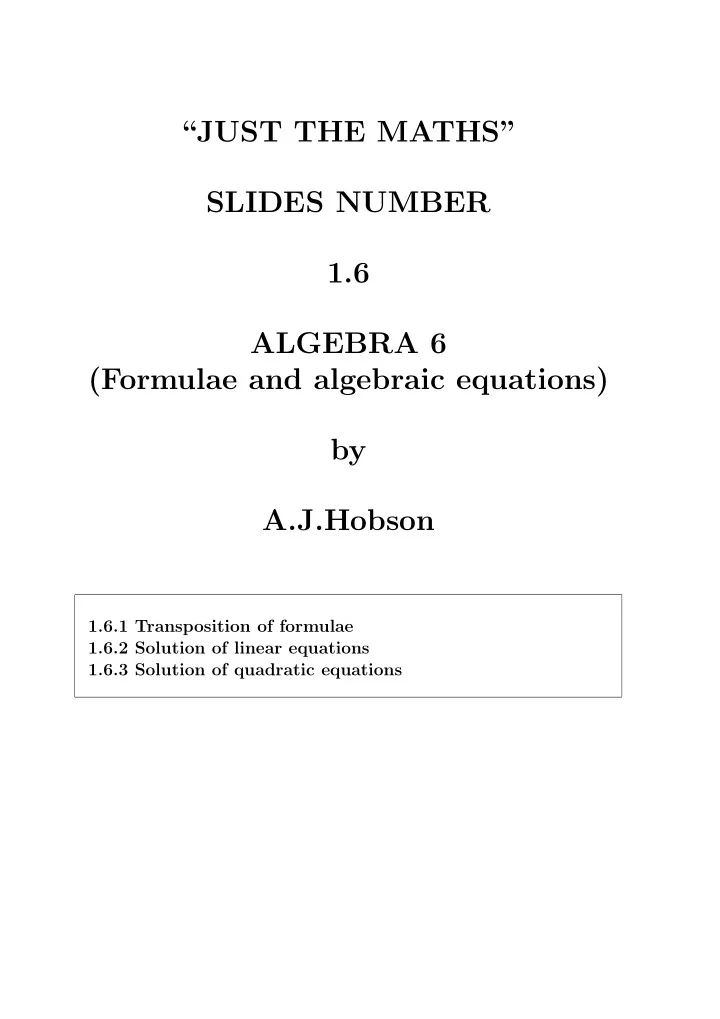

“JUST THE MATHS” SLIDES NUMBER 1.6 ALGEBRA 6 (Formulae and algebraic equations) by A.J.Hobson 1.6.1 Transposition of formulae 1.6.2 Solution of linear equations 1.6.3 Solution of quadratic equations
UNIT 1.6 - ALGEBRA 6 FORMULAE AND ALGEBRAIC EQUATIONS 1.6.1 TRANSPOSITION OF FORMULAE The following steps may be carried out on both sides of a given formula: (a) Addition or subtraction of the same value; (b) Multiplication or division by the same value; (c) The raising of both sides to equal powers; (d) Taking logarithms of both sides. EXAMPLES 1. Make x the subject of the formula y = 3( x + 7) . Solution y 3 = x + 7; x = y 3 − 7 . 1
2. Make y the subject of the formula � x 2 − y 2 . a = b + c Solution x 2 − y 2 ; � a − b = c a − b � x 2 − y 2 ; = c 2 a − b = x 2 − y 2 ; c 2 a − b − x 2 = − y 2 ; c 2 a − b x 2 − = y 2 ; c � 2 � a − b � � � x 2 − y = ± . � � c 2
3. Make x the subject of the formula e 2 x − 1 = y 3 . Solution Taking natural logarithms of both sides of the formula 2 x − 1 = 3 ln y. Hence x = 3 ln y + 1 . 2 Note: For scientific formulae, ignore the negative square roots. 1.6.2 SOLUTION OF LINEAR EQUATIONS If ax + b = c , then x = c − b a . EXAMPLES 1. Solve the equation 5 x + 11 = 20 . Ans : x = 20 − 11 = 9 5 = 1 . 8 5 2. Solve the equation 3 − 7 x = 12 . 3
Ans : x = 12 − 3 = 9 − 7 ≃ − 1 . 29 − 7 1.6.3 SOLUTION OF QUADRATIC EQUATIONS Standard form is ax 2 + bx + c = 0. (a) By Factorisation EXAMPLES 1. Solve the quadratic equation 6 x 2 + x − 2 = 0 . In factorised form, (3 x + 2)(2 x − 1) = 0 . Hence, x = − 2 3 or x = 1 2 . 2. Solve the quadratic equation 15 x 2 − 17 x − 4 = 0 . In factorised form (5 x + 1)(3 x − 4) = 0 . Hence, x = − 1 5 or x = 4 3 . 4
(b) By Completing the square EXAMPLES 1. Solve the quadratic equation x 2 − 4 x − 1 = 0 . Equation can be written ( x − 2) 2 − 5 = 0 . Thus, √ x − 2 = ± 5 . √ Ans : x = 2 ± 5 ≃ 4 . 236 or − 0 . 236 2. Solve the quadratic equation 4 x 2 + 4 x − 2 = 0 . Equation can be written x 2 + x − 1 = 0; 4 2 2 x + 1 − 3 4 = 0 . 2 4 Hence, 2 x + 1 = 3 4; 2 5
� x + 1 � 3 � � 2 = ± 4; � � √ � x = − 1 � 3 4 or − 1 ± 3 � � � . 2 ± � 2 (c) By the Quadratic Formula Given ax 2 + bx + c = 0 , x 2 + b ax + c = 0; a a 2 − b 2 x + b 4 a 2 + c = 0; a 2 a a 2 = b 2 x + b 4 a 2 − c 2 a a � � b 2 x + b 4 a 2 − c � � 2 a = ± � a ; � � b 2 − 4 ac � x = − b � � � ; 2 a ± � 4 a 2 √ b 2 − 4 ac x = − b ± . 2 a Note: b 2 − 4 ac is called the “Discriminant” . 6
The discriminant gives two solutions, one solution (coin- cident pair) or no (real) solutions according as its value is positive, zero or negative. EXAMPLES Use the quadratic formula to solve the following: 1. 2 x 2 − 3 x − 7 = 0 . Solution √ x = 3 ± √ 9 + 56 = 3 ± 65 4 4 = 3 ± 8 . 062 ≃ 2 . 766 or − 1 . 266 4 2. 9 x 2 − 6 x + 1 = 0 . x = 6 ± √ 36 − 36 = 6 18 = 1 3 only . 18 3. 5 x 2 + x + 1 = 0 . Solution x = − 1 ± √ 1 − 20 . 10 No real solutions. 7
Recommend
More recommend